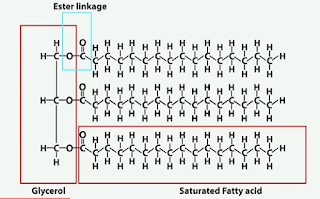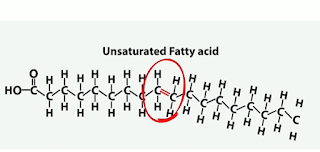Fats can be both good for you and bad for you.
For example, omega-3 fatty acids help your brain function normally and are known to be anti-inflammatory. On the other hand, Saturated fats raise the level of unhealthy cholesterol in your blood. This puts you at a higher risk of heart disease and stroke.
Let's take a look at the difference between saturated fats and unsaturated fats.
A fat molecule is composed of a 3 carbon glycerol head and three fatty acid tails.
The tails are a chain of carbons bound to hydrogen atoms. This is called a hydrocarbon chain.
All bounds between the carbons and hydrogen are single which creates a straight shape.
Due to this straight shape saturated fats are solid at room temperature. Examples include animal fats.
An unsaturated fat has a hydrocarbon chain that contains carbon atoms that bind to each other with a double bond.
These double bonds bend the unsaturated fat which makes the fat less compact and usually liquid at room temperature. Examples include plant and fish fats.
An unsaturated fat with one double carbon bond is a monounsaturated fat.
An unsaturated fat with multiple double carbon bonds are polyunsaturated fat.
In general unsaturated fats are healthier than saturated fats and trans fats..
Some unsaturated fats help the nervous system and decrease the risk for heart disease by decreasing the bad LDL cholesterol and increase good HDL cholesterol.







0 comments:
Post a Comment